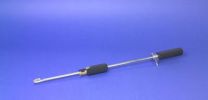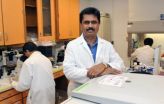(Press-News.org) More and more often, abdominal surgeries are being carried out in a minimally invasive manner. A small incision in the abdominal wall is sufficient for the surgeon to be able to insert the instrument and make the organs visible with an endoscope. This technique is gentler and does not stress the body as much as traditional surgeries do. However, these minimally invasive surgeries pose a special challenge to the surgeons. In particular, the suturing – meaning joining the tissue with needle and suture material - demands great skill and dexterity. Very often, piercing the tissue and tying the knots is difficult – after all, the surgeons must perform surgeries in very tight quarters, while having very little room to move. Unlike when sewing textiles, a knot must be made after every stitch, which is a very exacting process that stresses the patient and can cause a number of complications. If the suture is too tight, there is the danger of a minor hemorrhage. In addition, the suture material can cut into the tissue and strangulate vessels. In worst cases the tissue may even die. However, if the suture is too loose, there may be bleeding at the edges of the wound.
Currently, setting the correct suture tension depends on the experience of the surgeon. He must subjectively estimate the optimum tension – and do this anew for every surgery. He does not have access to a reproducible, standardized setting. In the future, a minimally invasive suturing instrument shall make suturing easier. The researchers of the Fraunhofer Institute for Production Technology IPT in Aachen have developed this instrument within the scope of the InnoNet project "The Suture" (see below). In a new, semi-automatic process the suturing instrument enables the surgeon to connect the suture material with a previously set, predefined tension. Not only does it shorten the suturing process with respect to time, it also hastens the healing of the wound. The patient is able to recover more quickly. "With our new device, the edges of the wound can be joined quickly and safely, since it automatically ensures the optimum tension for the suture. The surgeon no longer has to deal with that. In the future, the difficult task of knotting the ends of the suture material will no longer be necessary, since they simply will be welded with the laser," explains Dipl.-Ing. Adrian Schütte, a scientist at the IPT.
The idea for this process is based on the laser welding process for plastics. During this process, two thermo-plastic pieces to be lasered together are welded together by means of laser energy. Adrian Schütte said: "In our case, the suture material is one of the two pieces to be lasered together, the other one is the sleeve. It is located in the tip of the new suturing device, which has a diameter of ten millimeters."
But, how does the new process work? First, the surgeons access the abdominal cavity through a small tube – the experts call it a trocar. After they pierce the tissue with a needle, they pull the end of the suture material out with the surgical forceps, through the trocar, and clip it into the sleeve. A defined tension can be set for the suture by pushing the sleeve through the trocar and simultaneously tensioning the suture. Once the desired tension has been achieved, the suture material is welded to the sleeve by laser. The laser is located at the end of the suturing instrument, the laser beam is sent via the light conducting fiber through the instrument. The superfluous suturing material is cut off behind the sleeve. And, as a last step, the surgeons pull the suturing instrument out through the trocar. After the lasering, the sleeve remains in the abdominal cavity. Schütte remarked: "Currently, the sleeve consists of polypropylene, in the future we would like to manufacture it from resorbing materials."
Together with the InnoNet Project Partners (see below), the scientist and his team were already able to successfully carry out the suturing process during tests in the laboratory. The expert remarked: "We were able to achieve the best results with a suture tension of zero to five Newton and a lasering time of 0.1 seconds." The preclinical studies are slated to start in the course of this year at the Aachen university hospital. To begin with, the suturing instrument will be utilized for minimally invasive surgeries in the abdominal area. The researcher is convinced that it can also be adapted to keyhole surgeries of the heart. The researchers from the IPT will display a prototype of the minimally invasive suturing instrument at the MEDTEC Europe Fair in Stuttgart (Hall 11, Booth 6211) from March 22 - 24, 2011.
INFORMATION:
InnoNet-Project: The suture
By promoting innovative networks – InnoNet – the German federal ministry for economics and technology (Bundesministerium für Wirtschaft und Technologie BMWi) aims to increase the innovative force and competitive ability of medium-sized companies. The goal of the project "The Suture - Mechatronic Instruments for Complicated Sutures during Minimally Invasive Surgery" is to develop an automated suture aid for use in minimally invasive surgery. Project partners from the areas of research (Fraunhofer IPT and the Faculty for Applied Medical Technology at the RWTH Aachen) and medical technology manufacturers (Medi-Globe, Sopro-Comeg), manufacturers of medical sensor technology and measurement technology (LEA), specialists for medical suture material (FEG, Ethicon) as well as end users (Aachen University Hospital) work together to achieve the goals.
Minimally invasive surgeries: Laser suturing
2011-03-01
ELSE PRESS RELEASES FROM THIS DATE:
U. Iowa team investigates function of 'junk DNA' in human genes
2011-03-01
Part of the answer to how and why primates differ from other mammals, and humans differ from other primates, may lie in the repetitive stretches of the genome that were once considered "junk."
A new study by researchers at the University of Iowa Carver College of Medicine finds that when a particular type of repetitive DNA segment, known as an Alu element, is inserted into existing genes, they can alter the rate at which proteins are produced -- a mechanism that could contribute to the evolution of different biological characteristics in different species. The study was ...
Compound useful for studying birth defects may also have anti-tumor properties
2011-03-01
In an interesting bit of scientific serendipity, researchers at North Carolina State University have found that a chemical compound useful for studying the origins of intestinal birth defects may also inhibit the growth and spread of cancerous tumors.
During the screening of chemical compounds created by NC State chemist Dr. Alex Deiters, developmental biologist Dr. Nanette Nascone-Yoder found one of particular interest to her research: a compound that induced heterotaxia, a disordering or mirror-image "flipping" of internal organs, in the frog embryos she was studying. ...
Blood pressure management: Sleep on it
2011-03-01
A daytime sleep could have cardiovascular benefits according to new research by Ryan Brindle and Sarah Conklin, PhD, from Allegheny College in Pennsylvania in the US. Their study, looking at the effect of a daytime nap on cardiovascular recovery following a stress test, found that those participants who slept for at least 45 minutes during the day had lower average blood pressure after psychological stress than those who did not sleep. The work is published in Springer's journal International Journal of Behavioral Medicine.
Long work schedules, shift work, increased anxiety ...
IDIBELL researchers discover a substance against the 'dark genome' of cancer
2011-03-01
A research study coordinated by Manel Esteller, researcher at Bellvitge Biomedical Research Institute (IDIBELL) has identified a substance that inhibits cancer growth by activating the so‑called "dark genome" (or non‑coding DNA) and micro‑RNA molecules. The study appears this week in the journal Proceedings of the National Academy of Sciences (PNAS).
Human body cells have a genome (the set of our DNA) encoding our proteins such as keratin in the skin or haemoglobin in blood. This genome with encoding DNA represents only the 5% of our genetic material. ...
University of Cincinnati research presented at international criminal justice meeting
2011-03-01
About 1,200 criminal justice researchers as well as active and retired law-enforcement professionals from around the world are expected to attend the annual meeting of the international Academy of Criminal Justice Sciences, to be held March 1-5 in Toronto. Presentations of the latest research in the field will be made, including research presented by the University of Cincinnati faculty and students.
Recognized at the conference will be UC researchers Bonnie Fisher, professor, and Francis Cullen, distinguished professor. Fisher and Cullen will receive the 2010 Outstanding ...
BUSM study shows chemoradiotherapy prior to surgery improves survival
2011-03-01
Researchers from Boston University School of Medicine (BUSM) have found that patients with node negative T3 and T4 non-small lung cancer who underwent chemotherapy before surgery had more than three times the survival rate than patients who only underwent surgery. These findings currently appear on-line in the Journal of Thoracic and Cardiovascular Surgery.
The study looked at a total of 110 patients who underwent surgical resection for invasive T3 and T4 non-small lung cancer between 1979 and 2008. Forty-seven patients received neoadjuvant chemotherapy and concurrent ...
ISU research raises hope for solving Parkinson's disease puzzle
2011-03-01
AMES, Iowa - A protein pathway that may hold the secret to understanding Parkinson's disease has been discovered and explained by Iowa State University researchers.
Anumantha Kanthasamy, a distinguished professor of biomedical sciences and the W. Eugene and Linda R. Lloyd Endowed Chair in Neurotoxicology at the ISU College of Veterinary Medicine, has been working to understand the complex mechanisms of the disease for more than a decade. He believes this recent discovery offers hope for the cure.
The research was funded by the National Institutes of Health and is published ...
Study finds close linkage between a rare, deadly lung condition and blood cell abnormalities
2011-03-01
WASHINGTON, February 28, 2011) – Results from a study published in Blood, the Journal of the American Society of Hematology reveal a close relationship between pulmonary arterial hypertension (PAH)—exceedingly high blood pressure in the arteries carrying blood from the heart to the lungs—and abnormalities of the blood-forming cells in the bone marrow (known as myeloid abnormalities).
The study, which was conducted by a team of researchers at the Cleveland Clinic, showed that blood progenitor cells (cells that are capable of forming white blood cells, red blood cells, ...
U. of Colorado study shows acupressure effective in helping to treat traumatic brain injury
2011-03-01
A new University of Colorado Boulder study indicates an ancient form of complementary medicine may be effective in helping to treat people with mild traumatic brain injury, a finding that may have implications for some U.S. war veterans returning home.
The study involved a treatment known as acupressure in which one's fingertips are used to stimulate particular points on a person's body -- points similar to those stimulated with needles in standard acupuncture treatments, said CU-Boulder Professor Theresa Hernandez, lead study author. The results indicate a link between ...
Study finds breast cancer incidence rates no longer declining in US women
2011-03-01
ATLANTA –February 28, 2011– A sharp decline in breast cancer incidence rates among non-Hispanic white women in the U.S. after a dramatic drop in the use of postmenopausal hormone therapy did not continue through 2007, according to a new study from the American Cancer Society and the National Cancer Institute. While there are several possible explanations for the recent stabilization, it may indicate that the decrease in breast cancers thought to be related to postmenopausal hormone use has bottomed out. The study appears online in Cancer Epidemiology Biomarkers and Prevention ...



